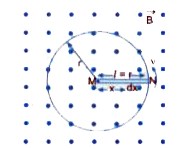A metallic rod of length 'l' is rotated with a frequency v with one end hinged at the centre and the other end at the circumference of a circular metallic ring of radius r, about an axis passing through the centre and perpendicular to the plane of the ring. A constant uniform magnetic field B parallel to the axis is present every where. Using Lorentz force, explain how emf is induced between the centre and the metallic ring and hence obtain the expression for it.
We know that a conductor has free charges. If a conductor of length .I. is moving perpendicular to a uniform magnetic field →B with a velocity →v perpendicular to its length too, then a Lorentz force →F acts on each free charge, where
∣∣→F∣∣=qvB
Due to this force free charges move along the length of conductor from one end to the other end and exact direction is given by Fleming.s left hand rule. As a result of this motion of charge, a potential difference is set up between the two ends of conductor. The potential difference developed (i.e., the induced emf) is given by
∣∣ɛ∣∣=FIq=qvBlq=vBl
Now, consider a conductor rod of length .l. hinged at one end Mand rotating about a normal axis passing through Mwith a frequency v, then for a small element of rod of thickness .de. situated at a distance .x. from the hinged end, the induced emf is
dɛ=Bvdx=B(xω)dx=B(x.2πv)dx=2πvBxdx
∴ Total induced emf
ɛ=2πvB∫10xdx=2πvB.[l22]=πvBl2

Similar Questions
A metallic rod of 'L' length is rotated with angular frequency of 'w' with one end hinged at the centre and the other end at the circumference of a circular metallic ring of radius L, about an axis passing through the centre and perpendicular to the plane of the ring. A constant and uniform magnetic field B parallel to the axis is present everywhere. Deduce the expression for the emf between the centre and the metallic ring.
View SolutionA metallic rod of length 'I' is rotated with a frequency v with one end hinged at the centre and the other end at the circumference of a circualr metallic ring of a radius r, about an axis passing through the centre and perpendicular to the plane of the ring. A constant uniform magnetic field B parallel to the axis is present every where. Using Lorentz force, explain how emf is induced between the centre and the metallic ring and hence obtain the expression for it.
View SolutionA metallic rod of 1 m length is rotated with a frequency of 50 rev/s, with on end hinged at the centre and the other end at the circumference of a circular metallic ring of radius 1 m, about an axis passing through the centre and perpendicular at to the plane of the ring. A constant uniform magnetic field of 1 T parallel to the axis is persent eveywhere. what is the e.m.f. between the centre and the metallic ring?
View SolutionA metallic rod of length 'I' is rotated with angular frequency of 'ω' with one end hinged at the centre and the other end at the circumference of a circular metallic ring of radius 'l', about an axis passing through its centre and perpendicular to the plane of ring. A constant and uniform magnetic field B parallel to the axis is present everywhere. Deduce the expression for the emf between the centre and the metallic ring.
View SolutionA metallic rod of length .L. is rotated with angular frequency of .omega. with one end hinged at the centre and the other end at the circumference of a circular metallic ring of radius R, about an axis passing through the centre and perpendicular to the plane of the ring. A constant and uniform magnetic field B parallel to the axis is present everywhere. Deduce the expression for the emf between the centre and the metallic ring.
View SolutionA metallic rod of length l and resistance R is rotated with a frequency v, with one end hinged at the centre and the other end at the circumference of a circular metallic ring of radius l, about an axis passing through the centre and perpendicular to the plane of the ring. A constant and uniform magnetic field B parallel to the axis is present everywhere.
(a) Derive the expression for the induced emf and the current in the rod.
(b) Due to the presence of the current in the rod and of the magnetic field, find the expression for the magnitude and direction of the force acting on this rod.
(c) Hence obtain the expression for the power required to rotate the rod.
View SolutionA metallic rod of length l and resistance R is rotated with a frequency v, with one end hinged at the center and the other end at the circumference of a circular metallic ring of radius l, about an axis passing through the centre and perpendicular to the palne of the ring. A constant and uniform magnetic field B parallel to the axis is present everywhere.
(i) Derive the expression for the induced emf and the current in the rod.
(ii) Due tot the presence of the current in the rod and of the magnetic field, find and expression for the magnitude and direction of the force acting on this rod.
(iii) Hence, obtain the expression for the power required to rotate the rod.
View Solution

